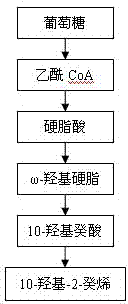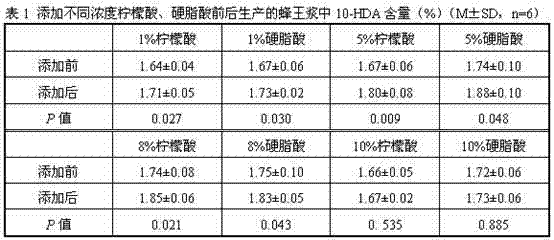Method for improving 10-hydroxy-2-caproleic acid content of royal jelly
A technology of decenoic acid and royal jelly, applied in application, animal feed, animal feed, etc., to achieve the effects of simple operation, increased content, and short feeding cycle
- Summary
- Abstract
- Description
- Claims
- Application Information
AI Technical Summary
Problems solved by technology
Method used
Image
Examples
Embodiment 1
[0014] see figure 1 , the inventive method is designed according to the synthesis pathway of 10-HDA in the honeybee body:
[0015] During the normal royal jelly production period, 48 production groups were randomly selected and divided into 8 groups on average, with 6 groups in each group. Before the experimental treatment, they were fed normal pollen feed. After the experiment started, 1%, 5%, 8%, and 10% citric acid or stearic acid were added to the pollen feed by mass percentage, and the operation continued for 9 days. The royal jelly produced before and after the addition of organic acids was sampled to determine the content of 10-HDA (results are shown in Table 1).
[0016]
[0017] As shown in Table 1, adding 1%, 5%, and 8% citric acid and stearic acid can significantly increase the 10-HDA content in royal jelly, while 10% citric acid or stearic acid has no significant effect. Among them, when the addition amount is 5%, the improvement effect is the best.
[0018] ...
PUM
 Login to View More
Login to View More Abstract
Description
Claims
Application Information
 Login to View More
Login to View More - R&D
- Intellectual Property
- Life Sciences
- Materials
- Tech Scout
- Unparalleled Data Quality
- Higher Quality Content
- 60% Fewer Hallucinations
Browse by: Latest US Patents, China's latest patents, Technical Efficacy Thesaurus, Application Domain, Technology Topic, Popular Technical Reports.
© 2025 PatSnap. All rights reserved.Legal|Privacy policy|Modern Slavery Act Transparency Statement|Sitemap|About US| Contact US: help@patsnap.com


